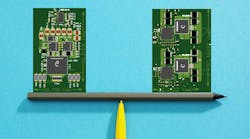Comparing Single-Phase Controller and Multiphase Converter Solutions (Download)
It’s become trendy to multiphase or stack devices as power requirements across applications continue to push controller solutions to limits that require a large bill of materials (BOM), larger solution sizes, and thermally challenging designs. Now that new converters can stack or multiphase their outputs to achieve higher output currents, the question becomes: “What’s the best solution—a single-phase controller or a paralleled two-phase converter?”
Here, we’ll compare a single-phase Texas Instruments (TI) LM5148-Q1 controller design to two TI LM70880-Q1 converters interleaved in a dual-phase design. These devices are good options for emerging 24- and 48-V end equipment in the automotive, enterprise, and industrial sectors, including hybrid electric vehicles (HEVs), onboard chargers, robots, and data-center servers. These applications require large input-voltage (VIN)-rated devices to handle transients as high as 65 or 80 V.
